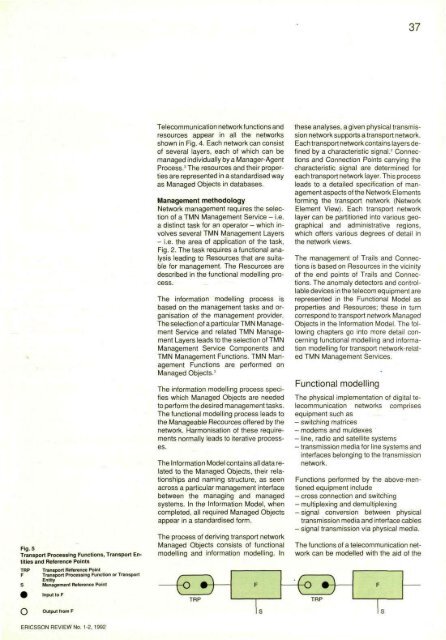Frame Relay - for Faster and More Efficient Data Communications ...
Frame Relay - for Faster and More Efficient Data Communications ...
Frame Relay - for Faster and More Efficient Data Communications ...
- No tags were found...
You also want an ePaper? Increase the reach of your titles
YUMPU automatically turns print PDFs into web optimized ePapers that Google loves.
37Fig. 5Transport Processing Functions, Transport Entities<strong>and</strong> Reference PointsTRPFSTransport Reference PointTransport Processing Function or TransportEntityManagement Reference PointTelecommunication network functions <strong>and</strong>resources appear in all the networksshown in Fig. 4. Each network can consistof several layers, each of which can bemanaged individually by a Manager-AgentProcess. 3 The resources <strong>and</strong> their propertiesare represented in a st<strong>and</strong>ardised wayas Managed Objects in databases.Management methodologyNetwork management requires the selectionof a TMN Management Service - i.e.a distinct task <strong>for</strong> an operator - which involvesseveral TMN Management Layers- i.e. the area of application of the task,Fig. 2. The task requires a functional analysisleading to Resources that are suitable<strong>for</strong> management. The Resources aredescribed in the functional modelling process.The in<strong>for</strong>mation modelling process isbased on the management tasks <strong>and</strong> organisationof the management provider.The selection of a particular TMN ManagementService <strong>and</strong> related TMN ManagementLayers leads to the selection of TMNManagement Service Components <strong>and</strong>TMN Management Functions. TMN ManagementFunctions are per<strong>for</strong>med onManaged Objects. 3The in<strong>for</strong>mation modelling process specifieswhich Managed Objects are neededto per<strong>for</strong>m the desired management tasks.The functional modelling process leads tothe Manageable Recources offered by thenetwork. Harmonisation of these requirementsnormally leads to iterative processes.The In<strong>for</strong>mation Model contains all data relatedto the Managed Objects, their relationships<strong>and</strong> naming structure, as seenacross a particular management interfacebetween the managing <strong>and</strong> managedsystems. In the In<strong>for</strong>mation Model, whencompleted, all required Managed Objectsappear in a st<strong>and</strong>ardised <strong>for</strong>m.The process of deriving transport networkManaged Objects consists of functionalmodelling <strong>and</strong> in<strong>for</strong>mation modelling. Inthese analyses, a given physical transmissionnetwork supports a transport network.Each transport network contains layers definedby a characteristic signal. 2 Connections<strong>and</strong> Connection Points carrying thecharacteristic signal are determined <strong>for</strong>each transport network layer. This processleads to a detailed specification of managementaspects of the Network Elements<strong>for</strong>ming the transport network (NetworkElement View). Each transport networklayer can be partitioned into various geographical<strong>and</strong> administrative regions,which offers various degrees of detail inthe network views.The management of Trails <strong>and</strong> Connectionsis based on Resources in the vicinityof the end points of Trails <strong>and</strong> Connections.The anomaly detectors <strong>and</strong> controllabledevices in the telecom equipment arerepresented in the Functional Model asproperties <strong>and</strong> Resources; these in turncorrespond to transport network ManagedObjects in the In<strong>for</strong>mation Model. The followingchapters go into more detail concerningfunctional modelling <strong>and</strong> in<strong>for</strong>mationmodelling <strong>for</strong> transport network-relatedTMN Management Services.Functional modellingThe physical implementation of digital telecommunicationnetworks comprisesequipment such as- switching matrices- modems <strong>and</strong> muldexes- line, radio <strong>and</strong> satellite systems- transmission media <strong>for</strong> line systems <strong>and</strong>interfaces belonging to the transmissionnetwork.Functions per<strong>for</strong>med by the above-mentionedequipment include- cross connection <strong>and</strong> switching- multiplexing <strong>and</strong> demultiplexing- signal conversion between physicaltransmission media <strong>and</strong> interface cables- signal transmission via physical media.The functions of a telecommunication networkcan be modelled with the aid of theERICSSON REVIEW No. 1-2,1992















